Guide to Different Types of IoT Healthcare Devices
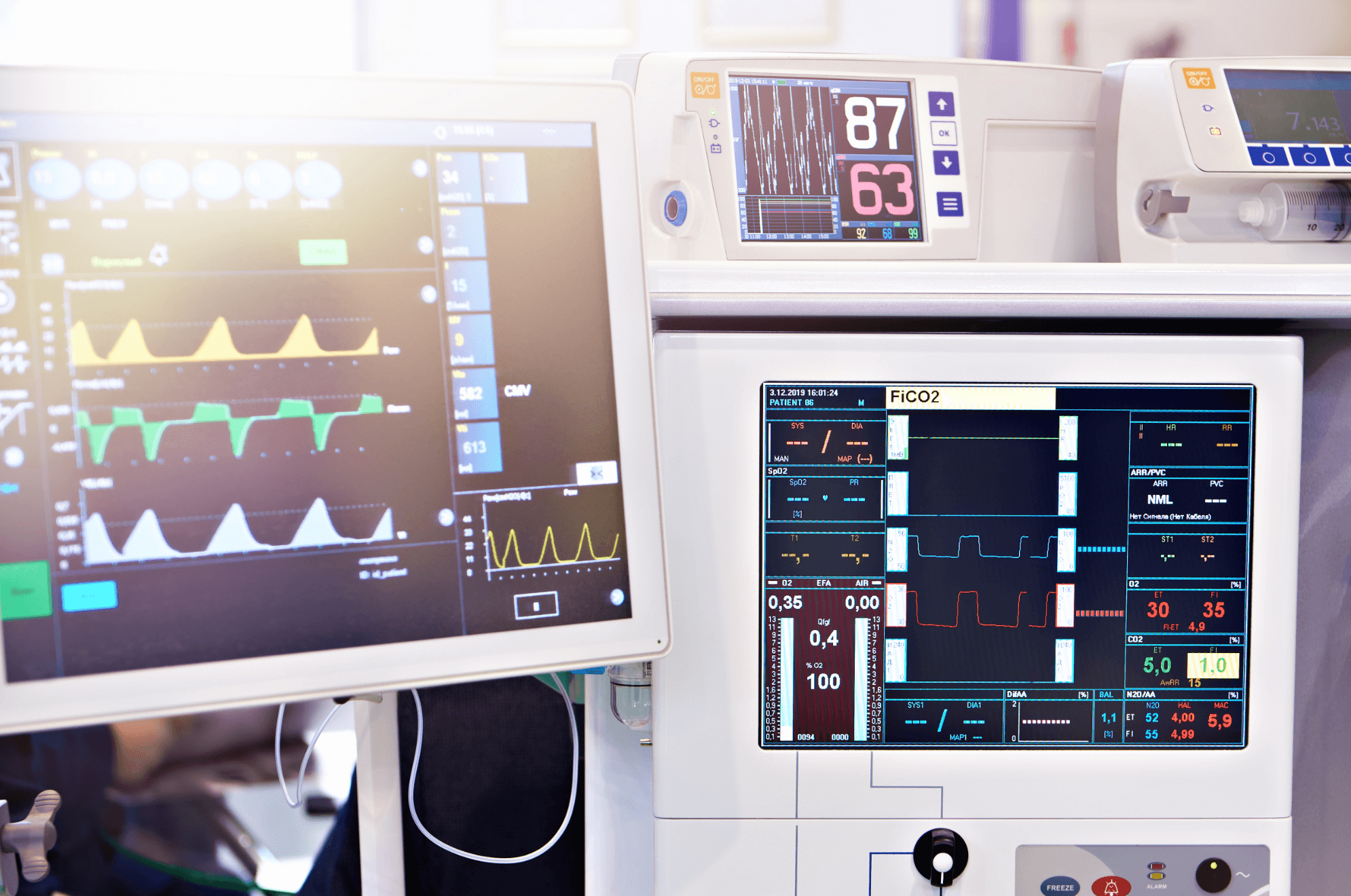
In the not-so-distant past, managing chronic conditions meant frequent hospital visits. Routine checks were marked on calendars, and patients spent precious time in waiting rooms. Thanks to IoT healthcare devices, health monitoring is no longer confined to hospital settings, and routine follow-ups are being gradually replaced with telemedicine. Today, it’s a reality for millions of patients and medical practitioners.
Wearables that monitor everything from heart rhythms to oxygen levels and implants that keep a watchful eye on glucose or other critical biomarkers allow for proactive treatment. Adjustments to medications and lifestyle can be made before the patient even notices a symptom. In short, healthcare IoT development brings a lot of positive changes to the sector and shows no sign of slowing down. The global IoT medical devices market is on track to balloon from $41 billion in 2023 to $166 billion by 2028.
Below, we’ll discuss the benefits of IoT devices in healthcare, review and understand the different types of connected medical equipment, and their role in improving patient care.
What are IoT Healthcare Devices?
IoT healthcare devices, also known as IoMT solutions, are smart, interconnected tools equipped with built-in sensors and other technologies that gather health data and transmit it via cloud computing. They track information like heart rate, blood pressure, oxygen levels, and other vitals and can alert both patient and doctor to any changes that might require action. It’s a true leap in chronic disease management, which offers a level of monitoring that was previously impossible outside of the hospital.
Apart from tracking capabilities, smart IoT devices can deliver medications, assist with rehabilitation, help prevent health issues before they arise, and so much more. Their connectivity allows for integration into larger health systems so that information flows securely and flawlessly between patients, devices, and doctors. Together, all these devices, along with software, protocols, data flows, and interfaces, form an IoT architecture that offers a structured way of communication between all these components within an ecosystem.
Benefits of IoT Healthcare Devices
The wealth of data supplied by IoT applications, when analyzed and applied, gives insights capable of tremendously improving patient care. These IoT devices’ advantages in healthcare are extensive and touch on nearly every aspect of healthcare delivery. Here are just a few of them.

Remote patient care. Healthcare IoT devices reduce the need for frequent in-person doctor visits. If the patient’s health condition doesn’t require taking immediate action, a virtual consultation with a doctor may well replace an actual physical visit. Remote patient monitoring tools and smart IoT sensors can track a lot of essential health indicators and send this patient data directly to healthcare providers.
Improved treatment and diagnostics. Specialists can now treat their patients better and faster. Connected medical devices, wearables, and other IoT devices used in healthcare gather and process the most comprehensive and precise data about a patient’s health status. With this information at hand, doctors can easily detect the early signs of disease or abnormalities, make accurate diagnoses before serious symptoms present themselves, and adjust treatment plans.
Better drug and equipment management. Among other things, healthcare devices IoT can be used to simplify the management of drugs and medical equipment. Smart IoT-based systems help medical staff keep a close eye on when and how medicines are used, making it less likely for mistakes to happen. On top of that, hospitals can rely on IoT to provide the right conditions for drug storage. Similarly, personnel can easily find the necessary medical equipment, avoiding lost or under-utilized stuff. This saves a lot of time, which can be spent on patient care.
Automation of processes. When part of the routine work is replaced with automation tools, all other processes are also accelerated. With IoT tracking of medical supplies, hospitals will always have restocked items as needed without manual counts or orders. In the treatment rooms, IoT devices for healthcare can automate the update of electronic health records with real-time patient data and alert doctors to any concerning changes. Even medication dispensing can be automated where smart systems manage dosages and schedules and notify patients when it’s time to take medication.
Cost-efficiency. As we said above, IoT healthcare device solutions automate part of the processes, which reduces the need for manual work and hiring staff. For instance, patient monitoring equipment reduces the hours nurses spend on routine checks, allowing them to manage more patients. Meanwhile, constant remote monitoring minimizes in-person visits at all, which helps clinics decrease overhead costs for space and staffing. In addition, IoT technology systems can diagnose medical equipment on time to prevent major breakdowns or replacements that are far more costly.
Types of IoT Healthcare Devices
The IoT healthcare device statistics are encouraging. Last year’s report by Juniper Research projected that smart hospitals will deploy over 7 billion IoMT devices by 2026. As you can understand, there is no lack of diversity and functionality, and the IoT healthcare devices list is quite long. All of them can be classified into different types, each serving different functions. Let’s examine their specific usage and IoMT device examples that fall under those categories.
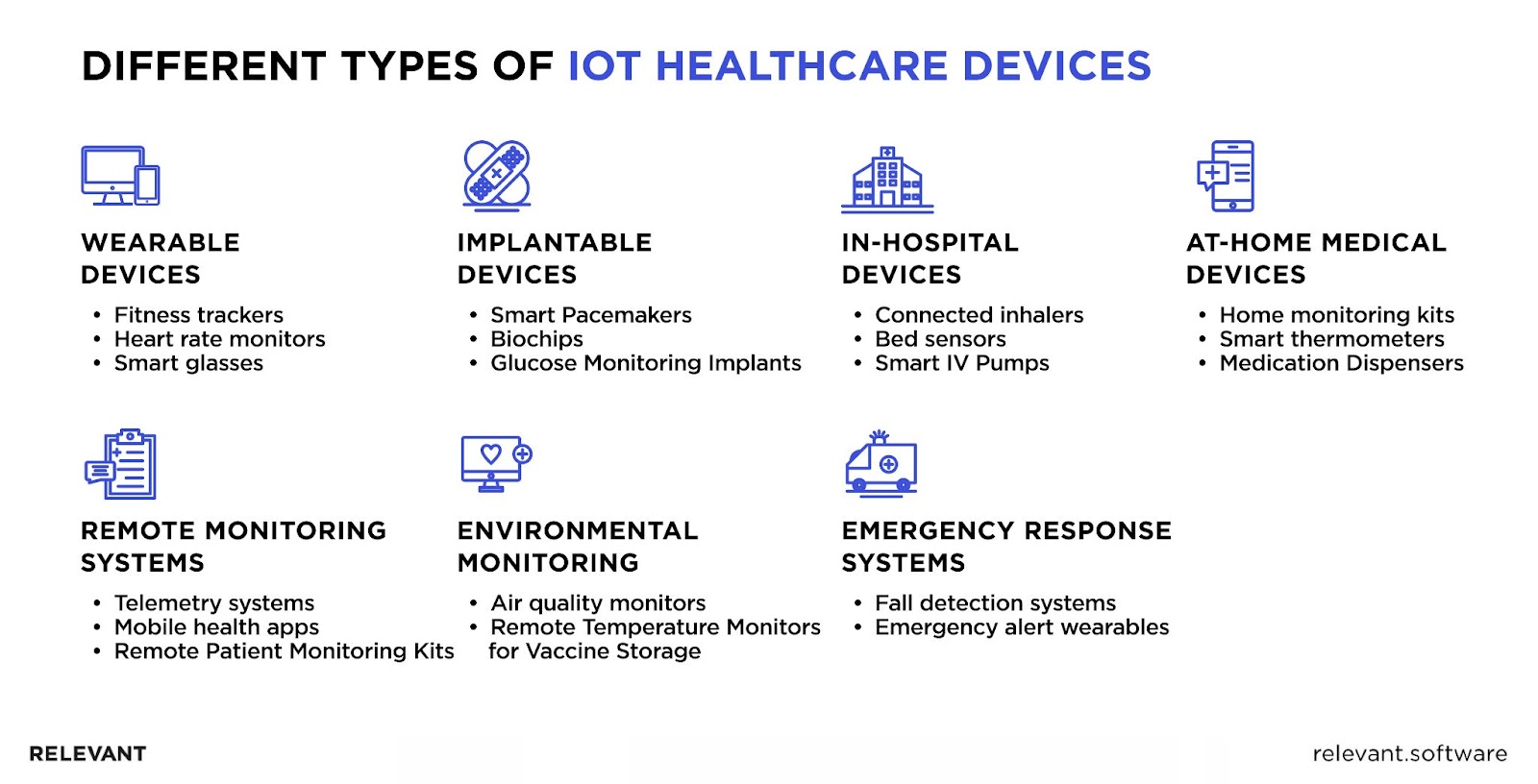
Wearable devices
Wearables have carved out a significant space for themselves in healthcare as a result of consumers’ increased interest in monitoring their health. If we compare the number of wearable devices shipped globally in 2014 – 28.8 million with 492 million in 2022, we have almost a 17-fold increase in just eight years.
So, these devices, usually worn on the body as accessories or implants, continuously track and analyze activity levels, vital statistics, and general health metrics. They serve two purposes: personal health tracking and out-of-hospital patient monitoring.
- Fitness Trackers. These wristbands use sensors to record the user’s physical activity, steps taken, pulse rate, and sleep patterns. While they are some of the basic forms of wearable IoT technology, they’re the most popular thanks to their convenience and easy sync with smartphone apps. More often, they’re used for personal health management.

- Heart Rate Monitors. Like fitness trackers, these devices have sensors that detect and measure specifically the heart’s rhythm and pulse. Typically, they’re incorporated into wristbands or chest straps. Athletes and fitness enthusiasts use these healthcare IoT devices to optimize their workouts, people with heart diseases to manage their cardiovascular conditions, and those who are simply looking to stay mindful of their heart health.
- Smart Glasses. Merging the digital and physical realms, these high-tech glasses improve medical practices by providing real-time data overlays that help professionals without interrupting their workflow. They are practical for supporting surgeons in the operating room and improving the daily lives of individuals with visual impairments. Smart glasses also sync effortlessly with healthcare systems, so vital information is just a glance away.
- Wearable ECG Monitors. These compact monitors, which often come in the form of straps or patches, measure and accurately provide electrocardiograms or ECG readings to the user’s doctor. They can detect abnormal heart rhythms or irregularities like arrhythmias and alert professionals for immediate intervention. It’s a real help for patients with heart conditions.
Implantable Devices
Implantable IoT devices healthcare professionals use to assist in the functioning of particular organs or tissues, observe physiological processes, or deliver medicines. They are placed inside the human body either temporarily or permanently, usually via surgical procedures.
- Smart Pacemakers. These small battery-operated devices are surgically placed within the chest to regulate abnormal heartbeat rhythms using electrical impulses. Beyond this primary function, smart pacemakers are equipped with sensors that monitor and record the heart’s electrical activity and then wirelessly transmit this data to physicians. They may be helpful after a heart attack when a patient’s cardiac rhythm is too slow, too fast, or irregular to stabilize it.
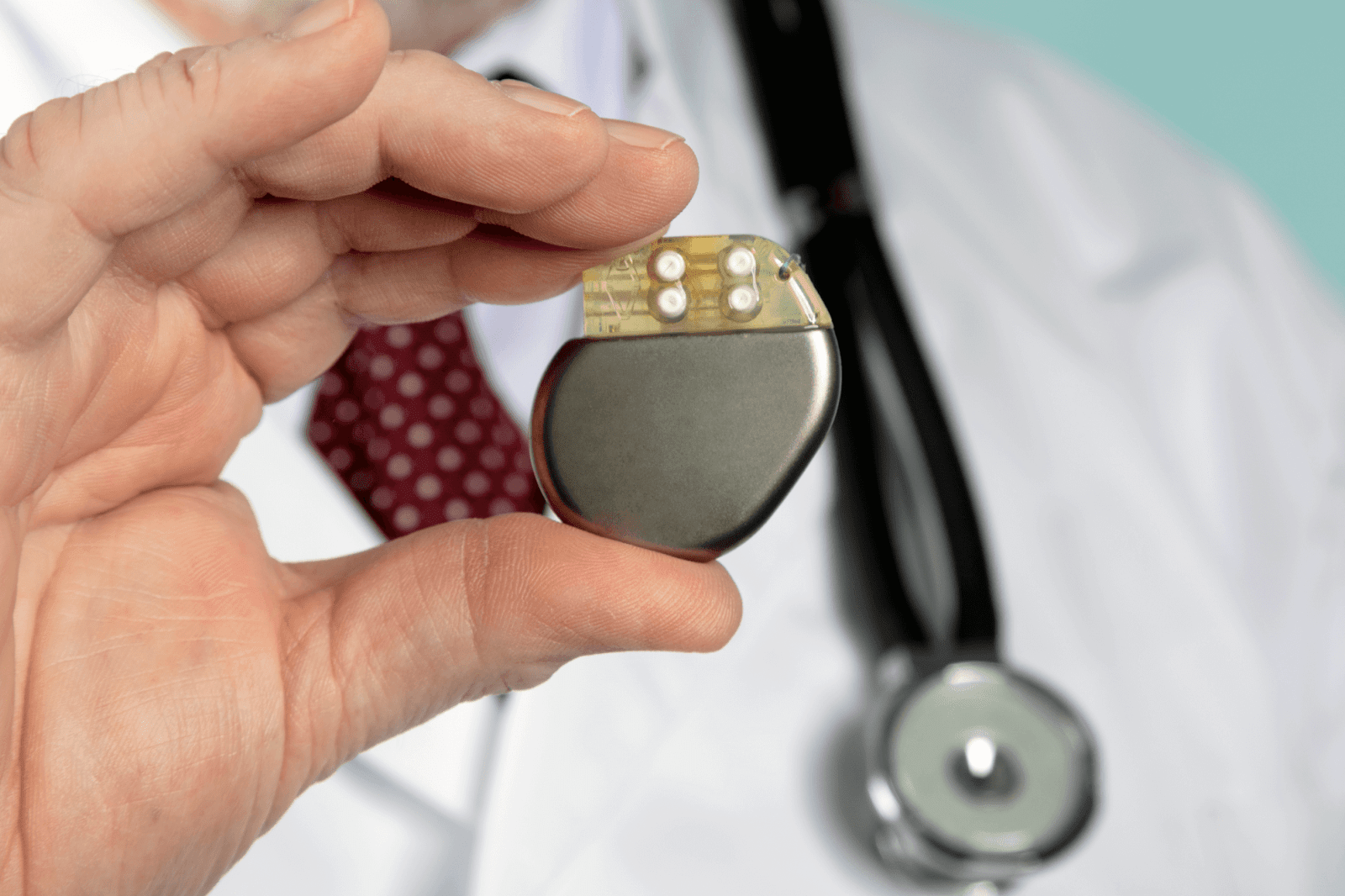
- Biochips. These tiny devices, smaller than the size of a dime, are implanted under the skin to monitor different patient’s physiological functions. Doctors can scan those biochips to retrieve patients’ health records right away. They can also rely on these micro healthcare IoT devices to report real-time changes to patients’ physical well-being, diagnose, and detect medical conditions. For example, biochips can track several biomarkers, like glucose levels and the presence of certain proteins associated with disease states.
- Glucose Monitoring Implants. Accurate implanted glucose monitors provide nonstop information on blood sugar levels and their patterns. These devices are useful for regulating insulin and monitoring glucose in people with diabetes. The collected information helps adjust the patient’s diet, exercise, or medication, offering a less invasive and more accurate alternative to traditional finger-prick tests.
In-Hospital Devices
Stationary medical devices traditionally used in hospitals and clinics are now also IoT-powered. They range from monitoring systems to sophisticated diagnostic machines and treatment equipment. They allow specialists to focus on treating the patient by delegating some of the tasks to connected medical devices.
- Connected Inhalers. These devices are connected to an app or healthcare software solution to remind people with respiratory diseases such as asthma and COPD to take their medicine. Besides medication usage tracking, smart inhalers monitor the frequency of attacks and record environmental data that helps doctors understand what triggers an attack.
- Bed Sensors. Hospital beds with special IoT sensors measure patients’ weight and movement and change the pressure on the mattress to prevent bedsores in critically ill patients. So, they automatically adjust the patients’ positions for better comfort, reducing the risk of pressure injuries.
- Smart IV Pumps. Today, smart intravenous (IV) pumps are the standard of care (87% of hospitals use them) in preventing errors related to medication delivery via infusion. So, these pumps deliver medicines and fluids to patients with precision, often programmed by clinical staff through software that ensures the correct dosage.
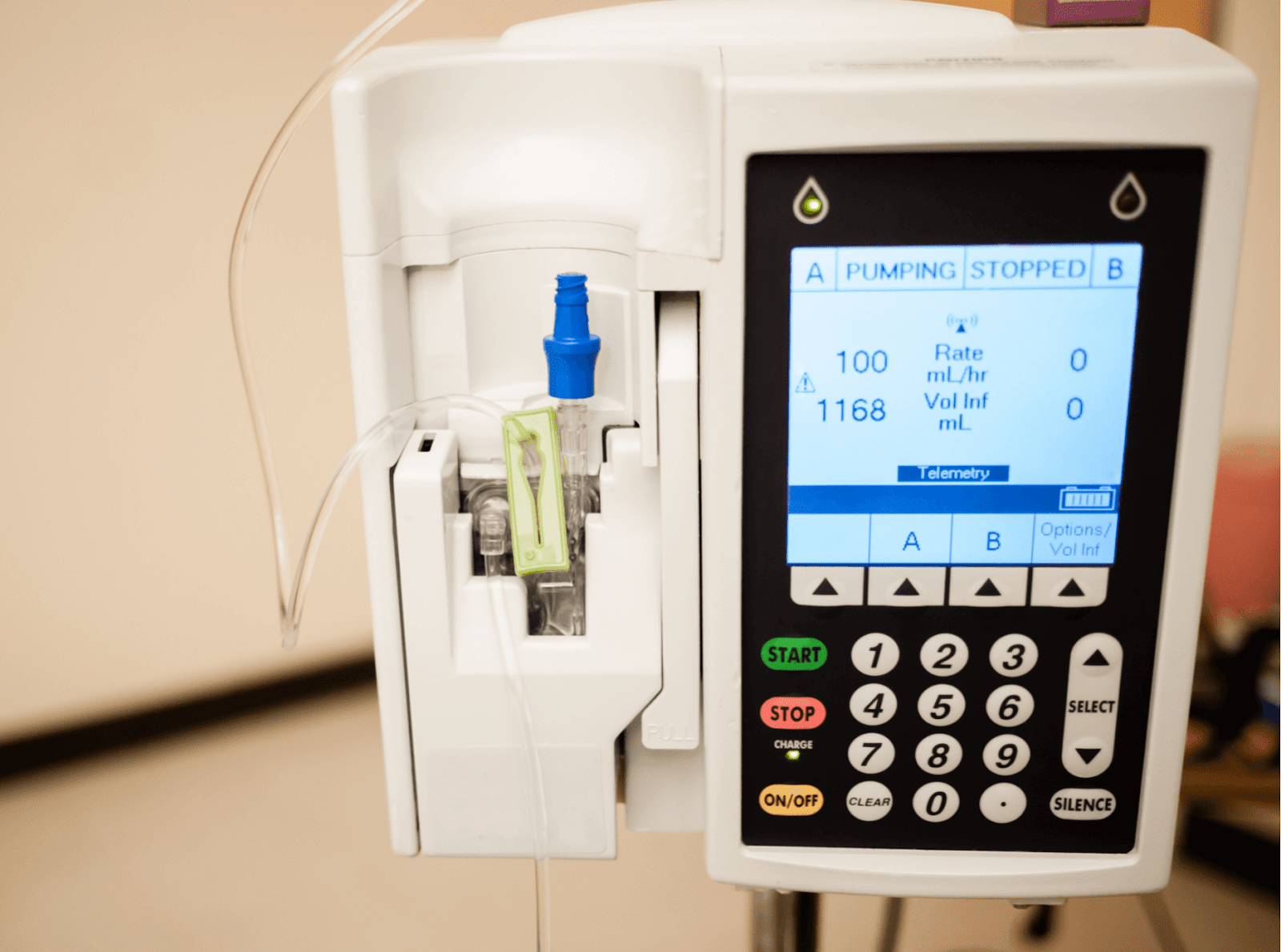
At-home Medical Devices
Care is gradually moving from hospital settings to home environments, where people use different IoT-enabled medical equipment to manage their health from the comfort of their homes. These home-use devices are varied and can benefit not only patients with chronic conditions but also individuals to prevent diseases and make better lifestyle choices.
- Home Monitoring Kits. At-home monitoring kits offer users the convenience of managing their health or certain medical conditions right where they are most comfortable – their homes. The kits may include sensors and devices for keeping track of blood pressure, sugar levels, and other critical vital to have a thorough picture.
- Smart Thermometers. Another IoMT device example is a Bluetooth thermometer that collects information on the patient’s temperature and sends it to an application. Then, individuals can use an app to find out how to treat illness by getting advice based on other factors such as age and additional symptoms.
- Medication Dispensers. These home-use devices in the form of smart bottles, wearables, or automated pill dispensers help users take medications correctly and on schedule. They dispense pills at a set time, remind patients to take medicines and alert caregivers if a dose is missed.
Remote Monitoring Systems
Remote patient monitoring (RPM) technology is one of the tools hospitals are increasingly turning to to improve outcomes and reduce costs of in-patient care. They use IoT-based applications in healthcare devices to monitor, report, and analyze patient health status outside of a traditional clinical setting.
- Telemetry Systems. These portable devices attached to the body offer continuous heartbeat tracking, which is crucial for patients with or at risk of arrhythmia. They measure the electrical activity of their heart and send this data to a central monitor for analysis. Doctors use telemetry tools to check for abnormal heart rhythms that indicate serious heart issues.
- Mobile Health Apps. While healthcare devices, IoT, cloud computing, and wireless technology enable remote monitoring, mobile health applications make them exceptionally easy to access. They bring a level of convenience and efficiency to monitor patients when it’s needed that traditional healthcare methods cannot match, allowing for immediate feedback and adjustments to treatment plans.
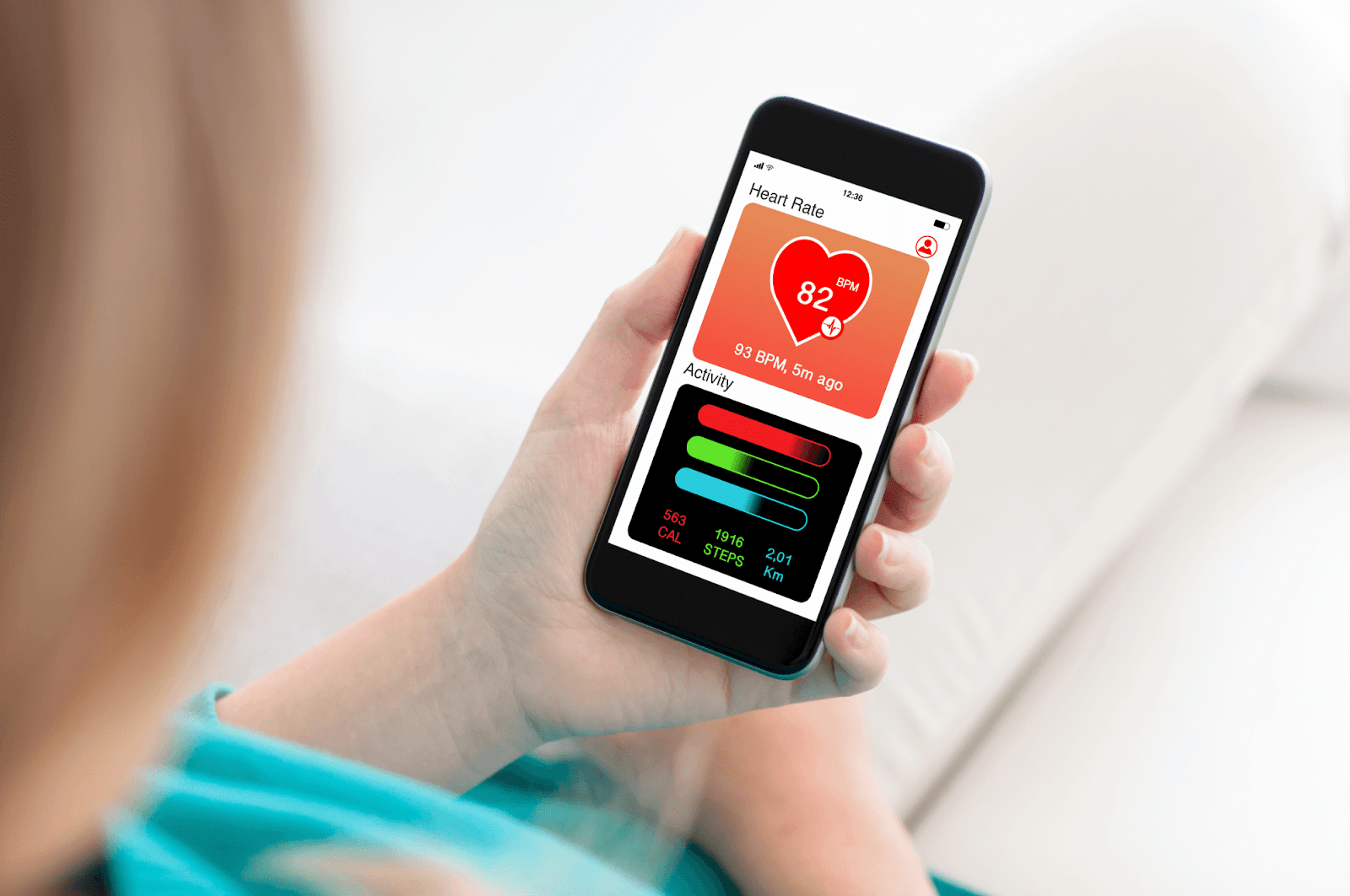
- Remote Patient Monitoring Kits. These kits typically consist of various devices and sensors that help caregivers monitor their patient’s health remotely. The collection of information on the patient’s heart rate, blood pressure, and other vital metrics helps specialists detect potential health issues early without the need for hospital visits. Usually, doctors use RPM kits to manage chronic conditions, monitor patients after hospitalization or surgery, or those who have difficulty traveling to the clinic.
RPM solutions become smarter and more affordable, and if you hire an experienced IoT developer, you can take advantage of this transformative tech. By the way, in our recent blog post, you can find all the benefits of remote patient monitoring solutions and how they help hospitals improve their bottom line.
Environmental Monitoring
The external environment of hospital areas can be smart, too. Powered by IoT technology, the systems controlling environmental parameters like air quality, temperature, and humidity can automatically adjust them for optimal conditions. It helps clinics maintain safety standards in critically vital areas like operating rooms and intensive care units and enhance patient well-being.
- Air Quality Monitors. IoT-enabled air quality monitors continuously track and assess levels of contaminants like dust, microbes, and chemical vapors to maintain a clean and safe environment. For example, in places like surgery rooms or isolation wards, these monitors activate purification systems whenever there’s too much dirt or harmful substances in the air.
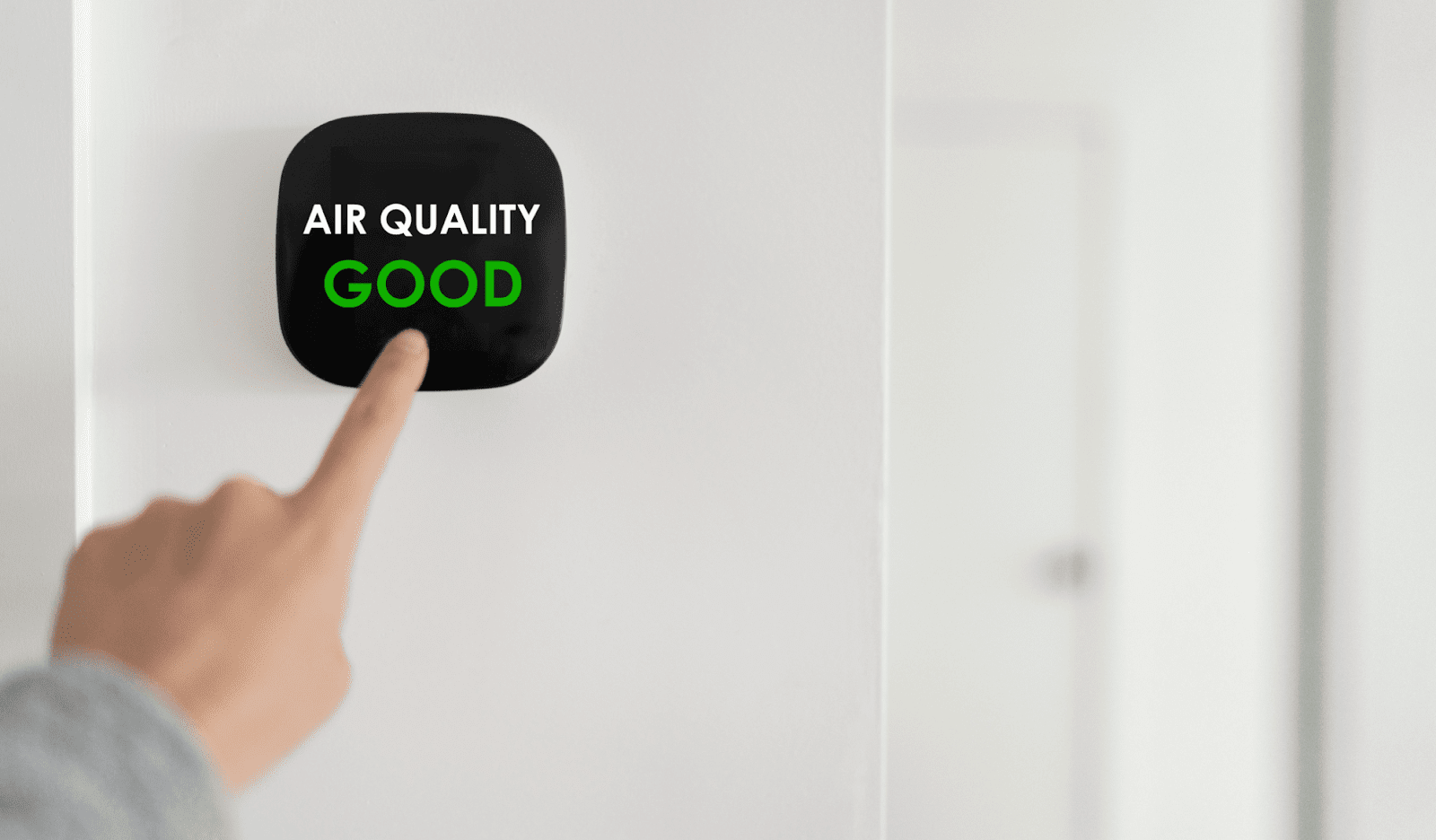
- Remote Temperature Monitors for Vaccine Storage. Hospitals use special IoT healthcare device solutions to keep vaccines at the right temperature. These devices check the temperature and report the storage conditions. If it gets too warm, the thermostat reacts and turns off the heating. This way, hospitals can guarantee the proper vaccine storage that doesn’t impact its effectiveness.
Emergency Response Systems
IoT applications in emergency response systems make them highly responsive and adaptable to critical situations due to real-time data collection and improved communication between systems. They alert staff, manage resources, and help coordinate care during life-threatening scenarios so that patients who require immediate attention get it in time. These smart-systems provide doctors and nurses with immediate updates so that they can react faster in emergency situations.

- Fall Detection Devices. Equipped to detect sharp, sudden falls, these devices or IoT sensors placed in patient rooms immediately notify medical staff of the incident, reducing the risk of injuries.
- Emergency Alert Wearables. Also known as medical alert systems, these devices offer a quick and easy way to call for help during an emergency, whether for a fall, sudden health deterioration or some other medical issues. Generally, these wearables all have a help button that alerts medical staff on an emergency situation.
Challenges and Concerns with IoT Healthcare Devices
Moving to the digital landscape brings many benefits to the medical industry. But there are also some risks in IoT healthcare devices that hospitals should be aware of.
- Data Privacy and Security. The collection and exchange of sensitive patient data understandably raise concerns in terms of information security and privacy. Unauthorized access and data breaches are just a few threats that are common and real. Therefore, data encryption and strict access controls are paramount for protecting patient confidentiality.
- Interoperability Issues. Lack of standardization often leads to compatibility issues, hindering the seamless functioning of a network of IoT devices and, ultimately, data exchange.
- Device Reliability and Malfunctions. Heavy reliance on healthcare IoT devices may cause hardware or software failures. To avoid possible malfunctions that can affect patient care, the systems need regular maintenance and ongoing monitoring.
IoT Healthcare Devices: Final Thoughts
IoT devices in healthcare have reshaped every aspect of the industry, delivering truly positive results. Medical organizations around the globe are rapidly embracing IoT, recognizing the value and benefits it brings. Sure, there are challenges, but the positives are too compelling to ignore. Fewer hospital visits, more efficient care, and better decisions made faster, among others, encourage clinics to deploy IoT solutions actively.
As a healthcare software development company that specializes in IoMT development, we know medical solutions should be reliable, secure, and meet industry standards. With this in mind, we build high-quality IoT applications as per your requirements and integrate them smoothly into existing healthcare infrastructures without disrupting your business. Just contact us and let us know what you need.



